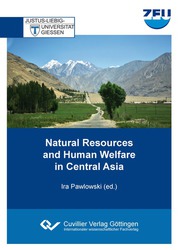| Areas | |
|---|---|
| Serie de libros (96) |
1378
|
| Nachhaltigkeit |
3
|
| Gesundheitswesen |
1
|
| Letra |
2365
|
| Medienwissenschaften | 16 |
| Teología | 57 |
| Filosofía | 102 |
| Derecho | 422 |
| Economía | 850 |
| Ciencias sociales | 416 |
| Ciencias del deporte | 48 |
| Psicología | 233 |
| Educación | 190 |
| Historia | 182 |
| Arte | 111 |
| Ciencias culturales | 166 |
| Literatur | 117 |
| Lingüística | 88 |
| Ciencias Naturales |
5406
|
| Ciencias Ingeniería |
1793
|
| General |
98
|
|
Leitlinien Unfallchirurgie
5. Auflage bestellen |
|
Erweiterte Suche
Natural Resources and Human Welfare in Central Asia (Tienda española)
Ira Pawlowski (Editor)Previo
Indice, PDF (64 KB)
Lectura de prueba, PDF (860 KB)
The region of Central Asia comprises extremely diverse ecosystems: high mountains, big rivers, vast agricultural areas, deserts and semi-deserts. Natural resources, especially water and arable land, are essential means of livelihood in Central Asia where the majority of the population lives in rural areas. The increasing scarcities of those resources together with conflicts over their use endanger the welfare of the people in the region.
The book reflects a multidisciplinary and cross-national approach in investigating the broad topic of land use and its interrelation with physical processes of the biogeosphere, economic development, and human welfare. The book includes contributions on: the impact of climate change on glacier retreat; dust deposition in the course of the desertification of the former Aral Sea; remote sensing analysis of earthquakes and landslides; hydrological modeling of irrigation and drainage systems; the role of remittances and income growth for the agricultural sector; food security of farm households; the impact of direct agricultural policies and changing macroeconomic conditions on agricultural incentives; the Kyoto Protocol and its legal implications for land-use; pasture and grazing management strategies.
| ISBN-13 (Impresion) | 9783954047604 |
| ISBN-13 (E-Book) | 9783736947603 |
| Formato | A5 |
| Idioma | Inglés |
| Numero de paginas | 252 |
| Laminacion de la cubierta | Brillante |
| Edicion | 1. Aufl. |
| Lugar de publicacion | Göttingen |
| Fecha de publicacion | 15.07.2014 |
| Clasificacion simple | Publicaciones universitarias |
| Area |
Derecho
Economía Geociencias Agricultura |
| Palabras claves | Hochschulschrift, Internationales Recht, Ausländisches Recht, Volkswirtschaftslehre, Physische Geographie, Meteorologie, Klimatologie, Aeronomie, Pflanzenproduktion, Zentralasien, Landnutzung, Gletscher, Erdbeben, Wüstenbildung, Bewässerung, Agrarpolitik, Ernährungssicherung, Weidewirtschaft, Kyoto Protokoll |








